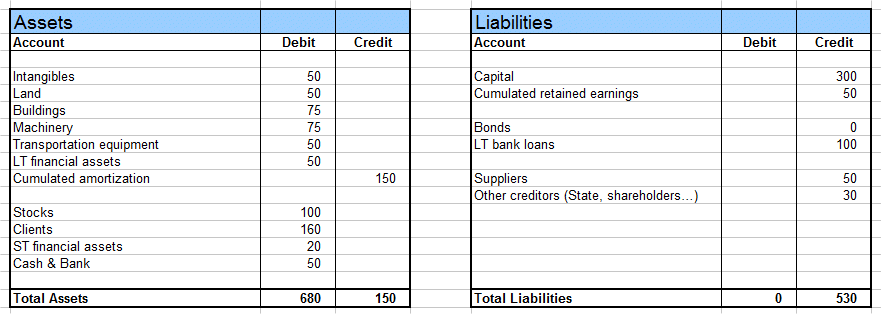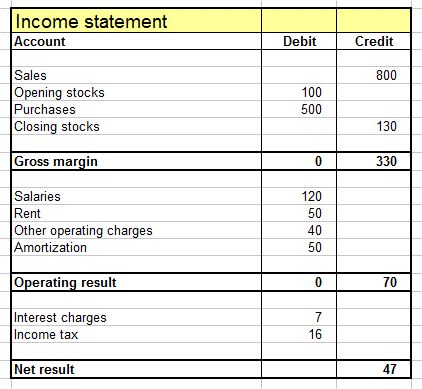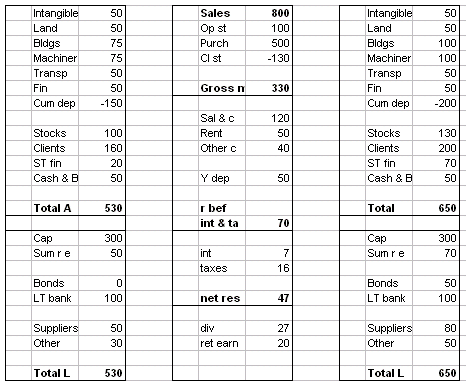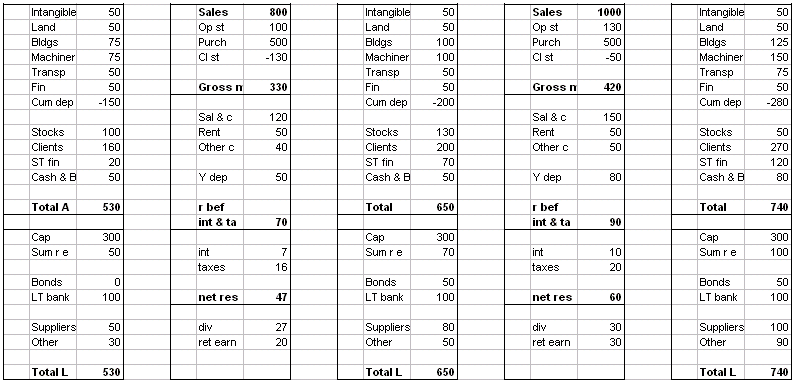General accounting
IX. 36. Analysis of the firm's year-end documents over several years
Video
In this lesson, we begin to use year-end documents (IS & BS) to assess how a firm is doing over several years, with the aim of understanding its prospects and future.
We shall study a firm over two years, which are after its first year of existence. So the five documents we shall look at are:
- beginning balance sheet
- income statement of the first year of analysis
- ending balance sheet, which is also the beginning BS of the second year of analysis
- income statement of the second year
- ending BS of the second year
When it is well managed, a firm is a value producing device (in common parlance, a "money making machine").
Let's read and interpret the beginning BS in our analysis (remember: this is not the initial year of existence of the firm).

The asset side of the BS shows the structure of all the tools to produce value. Here we see Gross Fixed assets of 350, Net Fixed assets of 200 (that is the value of the Gross Fixed assets minus amortization) and Current assets of 330.
The liability side shows how all the assets are financed. We go into details on this below.
Fixed assets:
The intangibles are patents which the firm acquired in the past, as well as the expenditures for the founding of the firm, which in most countries are not passed as charges of the initial year, but are "capitalised", that is treated as assets. In other words, the expenditures for the foundation of the firm (lawyers fees, announcements in legal publications, etc.) are recorded, in the ledger, in "capital accounts" (also called "balance sheet accounts").
The firm of our example owns land, buildings, machinery and transportation equipment. The last three are progressively amortized, while land, in accounting, is never amortized.
Remember that the assets are recorded in the BS at their acquisition cost, which may not be their market value today. This is particularly true of land.
The long term (LT) financial assets are titles of ownership of subsidiaries (partial or total), as well as other financial securities the firm intends to keep for a long time.
Current assets:
The current assets present the usual items: stocks, clients's IOU, short term financial assets (that is idle cash that has been "parked" into ST securities yielding some revenue) and cash & bank (which I've lumped together).
Liability side:
The liability side shows how the assets are financed.
It is an important way to look at liabilities. They show that the assets are financed in three big ways:
- The first source of financing is the shareholders: with their initial capital, and the earnings they decided not to receive as dividends but leave in the firm. The retained earnings is called "auto financing".
- The costly debts, that is money borrowed on a long term basis from banks or directly from the financial markets (bonds)
- The free debts: the suppliers and the other creditors in fact offer free financing to the firm until it actually pays these credits.
First Income Statement:

We are already familiar with this document.
The top part (up to the gross margin) is called the trading account. It presents the sales minus the cost of goods sold (here COGS = 470).
Then we have (up to the operating result) the "operating charges". They are the charges, on top of the COGS, to operate the firm and produce value. The first three are called "cash operating charges" (even though the rent and the other operating charges may be paid with IOUs!), and the amortization is a "non cash operating charge".
Below the operating result, the interest charges depend only on the structure of financing, that is the liabilities. If the firm had no costly debt (because it were financed strictly with the net worth and the free debts) it would pay no financial charges. Here it has 7 of interest charges; it is the "renting cost" over the year of the 100 of LT loans.
Finally the income tax of the year is calculated on the [operating result - interest charges]. The rate depends upon countries, periods, economic sectors, and the will of the Government to help or not such and such sector.
We say that "the interest charges" are a charge before tax, because it is not in the result used to compute the taxes (which was 63). Whereas the dividends are extracted from the result after tax.
Balance sheet at the end of the first year.
(For the sake of the analysis, what in the preceding lesson was "last year" has now become "two years ago".)
Let's look at the BS and IS in the following presentation. The BS at the end of the first year is the column on the right:
BS year -1 IS year BS year

We see that the buildings and machinery each increased by 25. Let's consider in this example that the firm sold no assets during the year. Then these increases in gross FA correspond to investments in buildings and in machinery.
The cumulated amortization (also called cumulated depreciation) went from 150 to 200. The difference can be checked: it is the yearly amortization of 50 showing in the IS.
The stocks went up from 100 to 130. It may be a good news or a bad news depending upon the type of firm. We shall compare stocks to the COGS in the lesson on ratios.
Ideally the stocks should be low, because they require financing. But when they are too low, we may miss sales. It is not possible to say what is a good level in general. It depends on each economic sector. In jewelry a high stock is a good thing, although it is even better, when possible, to carry the stock on loan from suppliers of jewels. In grocery retailing you don't want to have too high a stock, at least for the perishable products.
The clients line went from 160 to 200. Generally speaking a sale cash is better than a sale on credit, but if the clients on credit are good clients we want to have them and a high client balance is not bad. On the other hand if these clients correspond to desperate sales to uncreditworthy people it is a bad sign.
On the liability side, the retained earnings increased from 50 to 70. This corresponds to the 20 of retained earnings of the year.
The firm borrowed money from financial markets in the form of bonds. The account went from 0 to 50. The LT loan did not change.
The other creditors evolved a bit. We will see, in the lesson on ratios, what to think of the level of this account. Ideally, you want it to be high, because it is free financing. But if you pay your suppliers with excessive delay you may lose them.
The IS and BS are only syntheses. They do not show all the transactions of the year. They only help us understand the big evolutions, and see where there may be questions. When we want to understand better the evolution of an item, we must go back to the ledger and the accounts.
The analysis of evolution of the cash & bank account, which is the result of all sorts of transactions, is the subject of the "cash flow statement". We explain it in a lesson to come devoted to the cash flow statement.
Second year. Here is the synthetic presentation of two years.
BS year -1 IS year BS year IS year BS year

We continue looking at the evolution of items one by one.
Income statement
The sales went up from 800 to 1000, a 25% increase. A priori it is of course a very good news. The gross margin, which was 41,25% of sales, is now 42%. No problem here.
The Net result is at 60.
Notice that a positive Net result by itself is not enough to say that the firm is doing well. It depends how this Net result was reached. If it comes from healthy operations it is good. If it comes from ruthlessly slashing costs and preparing problems for the future, it is not good.
It may also come from nonrecurrent windfall, for instance the sale of some land with a huge profit on its book value, etc. But in this example we assume that the firm "divests" nothing.
Balance sheet
The firm invested even more in buildings (+25), machinery (+50) and transportation equipment (+25).
The stocks went down from 130 to 50. We must ask ourselves why ? It may be the sign of a better management of the stocks, purchases and sales. But it may also be the sign that the firm no longer has the means to operate normally and is "selling its stocks". Only a finer analysis inside the firm will answer the question.
The clients went up again from 200 to 270. There again, why ? Is it that we sell desperately on credit to new clients who will never pay, or is it the sign of a healthy development. Only a deeper look at our clients will answer the question.
We shall compare the clients figure to other measures in the firm to assess this item. It will be treated in the lesson on ratios.
No noteworthy evolution in the liabilites.
Need to look at the environment.
This very cursory analysis, to begin to show how we use the IS and BS to understand the firm, see where there are problems and questions, should not lead us to think that an internal analysis of the accounting documents of the firm is sufficient to have an idea of its health, prospects and future.
We must also look at its environment:
- markets
- market shares
- competitors
- accounts of competitors
- selling organisation of competitors
- production organisation
- technological choices (products, production)
- etc.
Each firm competes usually in several markets. In the jargon of strategy they are called "segments". They are "arenas" or "battlefields". The competitors and the rules of competition are different in each battlefield.
Running a firm is, in an essential way, to be in competition with other players, other firms.
To gather information on markets and competitors, we can use:
- market studies sold by specialized firms (for instance Nielsen, but there are many other).
- competitors accounts (they are of course very global, while we would need managerial accounting figures, which are not public)
- interviews with clients, suppliers, regulatory bodies, etc.
- interviews with competitors: sometimes even they accept to talk, at trade shows or in private encounters.



